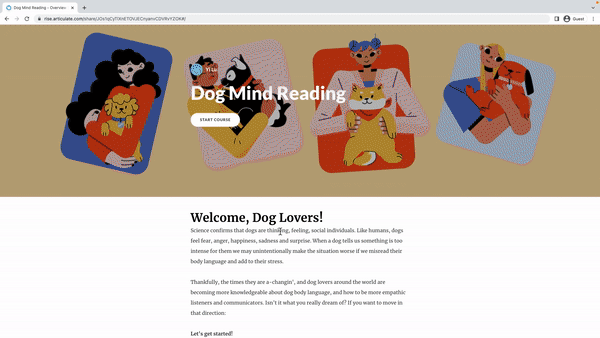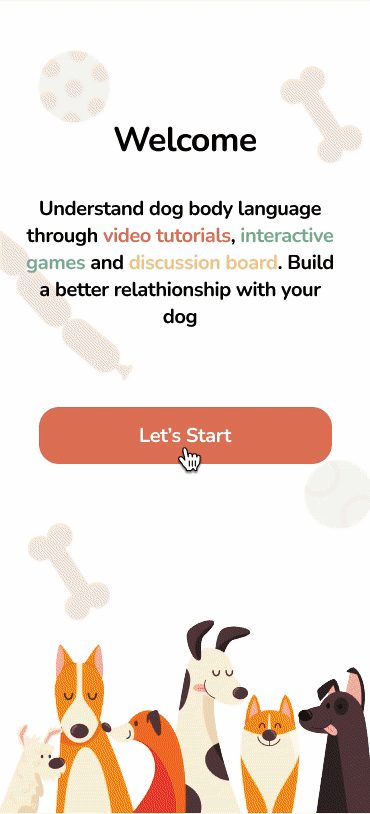Yi Lu
Project Overview
Like humans, dogs are thinking, feeling, social individuals. They can feel fear, anger, happiness, sadness and surprise. However, sometimes, we may unintentionally make the situation worse if we misread dogs' body language. How can we be more responsible guardians and caregivers by accurately reading dogs' body language?

1
2
3
4
5
6
Instructional Design Journey
You can also click the lables below to jump to each section.

We conducted task analysis, needs analysis and learner analysis by interviewing SMEs and distributing surveys to learners.
We proposed three design ideas: tutorials, interactive games and the discussion forum to tackle learning challenges.
We prototyped the first and second design ideas, tutorials and interactive games in Rise 360 and Figma.
We work with four individual “proxies” learners to evaluate whether the learning experience is both engaging and effective.
Task Analysis
Procedure Workflow of Preventing Dogs' Behavioral Problems through Body Language

Learning Goal:
After learning dogs' body language, learners will be able to understand signals sent from their puppy by reading the dog’s body language.
Learning Objectives:
Behavioral problems:
-
Learners will be able to prevent dogs’ behavioral problems by reading the dog’s body language.
-
Learners are able to identify dogs’ possible emotional states by looking at their whole body.
-
Learners will be familiar with a range of dogs’ emotional states such as fear, anger, happiness, excitement, etc.
-
Learners will be able to comprehend dogs’ emotional states by reading whole body language such as tail, eyes, posture, ears, etc. based on the context.
-
Learners will be able to identify the root cause of dogs’ behavioral problems.
Health problems:
-
Learners will be able to Identify whether the dog is healthy or not by external state, such as mood (depressed, inactive, etc.) and behavior.
-
Learners will be able to determine the dog's abnormal reaction so that prevent health problems.
Learner Persona


1. Analysis
Research Process




Needs Analysis
The main roadblocks of learning dog’s body language are:
-
Online misinformation
-
People may not be patient enough and not hold the dog accountable to go through hard times with the dog.
-
People are overwhelmed by the dog’s cuteness, so they don’t spend enough time and pay much attention to the dog's body language.
Then these difficulties lead to the knowledge gaps such as misinterpretation and misconceptions. For example, not all the dogs love to be petted, but when the dog shows it is uncomfortable, dog owners ignore the subtle signal or misinterpret it. Then if the dogs’ attempts of communication are not received, they will resort to barking, which is labeled as a behavior problem, but actually they are just telling you that they are scared. Therefore, if the dog owner can be aware of the dog’s feelings earlier, the “behavior problem” can be avoided.
Right Info + Right Attitude + Practice = Competency
Right Info
To debunk misconceptions
Attitude
be patient and pay more attention to dogs‘ attempts of communication.
Practice
Always look at the whole body.
Everything is contextual.
Every dog is an individual.
2 & 3. Design and Development
Design Ideas
To tackle the problems of right information, right attitude, and enough practice, we come up with three early design ideas interms of activities, media and learning theories and strategies:
Idea #1: Tutorials with Rise Modules -> Right information to debunk misconception

Idea #2: Interactive Games -> More opportunities to practice

Idea #3: Discussion Forum -> Build connections with other learners and then gain right attitudes


5. Evaluation
Executive Summary
We work with four individual “proxies” learners to evaluate whether the learning experience is both engaging and effective. Based on the results, we remove some obvious errors and omissions in terms of usability and instructions, adjust the content to make it less overwhelming.
Purpose
-
Does every step make sense to learners?
-
Can they understand what each button and page mean?
-
Did task performances align with our learning objectives and goals? (What do they learn from each task?)
-
Do we have enough content or too complicated for learners?
-
Did learners keep up with their pace or lose their patience to learn?
Methodology
Methods:
-
Think-aloud
-
Interview
-
Observation
Participants:
-
We asked 4 classmates with varying degrees of experience of having a dog and prior knowledge of dog’s body language as the proxies for the learners.
Instruments:
-
Google docs to take notes
-
Mural board to organize notes
Results
The tutorial is effective but could be more fun and engaging:
-
Participants who finished tutorials first can successfully complete the tasks in the game.
-
Participants suggest the content could be chunked, or there could be less text and more videos. They felt overwhelmed and lost patience when they read through all the content.
-
There could be more feedback.
The game is effective and engaging, but with minor omissions in terms of usability.
-
The game flow is smooth and instruction is clear.
-
The icons of the backpack, magnifier, and hints on the “Congratulations” page are confusing.
-
The user experience of observation of the dog's body parts could be more smooth.
-
The feedback on the wrong answer in the game could be more clear. Instead of only providing a link of the tutorial content they can refer back to, there could be more actionable feedback or more granular information that explains the scenario.
The connection between the tutorials and game:
-
The format of both tutorials and game is similar as they are both scenario-based questions and tasks. Participants suggest the game could be more interactive and given more autonomy to explore the “Dog City” to differentiate from the tutorials.
-
The tutorial and game could be on the same platform.
-
The visual is consistent.





